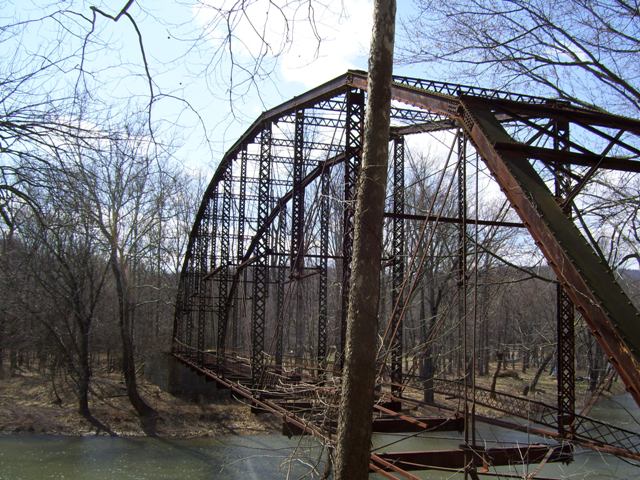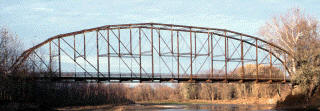We Recommend:
Bach Steel - Experts at historic truss bridge restoration.
BridgeHunter.com Phase 1 is released to the public! - Visit Now
Fisher Ford Bridge

Primary Photographer(s): West Virginia Department of Transportation
Bridge Documented: March 1, 2008
Rural: Morgan County, West Virginia: United States
1912 By Builder/Contractor: Owego Bridge Company of Owego, New York
Not Available or Not Applicable
245.0 Feet (74.7 Meters)
245.0 Feet (74.7 Meters)
Not Available
1 Main Span(s)
Not Applicable

View Information About HSR Ratings
Bridge Documentation
This bridge no longer exists!
View the State Level Recordation For This Historic Bridge
This historic bridge was demolished!

This bridge is an exceptional example of a pin-connected Pennsylvania through truss. Among the truss-rich states, the pin-connected Pennsylvania truss ranges from very uncommon to extremely rare. It is not known how many such examples survive in West Virginia. The bridge was historically and technologically significant as a largely unaltered example of an uncommon and complex truss bridge type. With a medium span length for the truss configuration, the bridge was an excellent representative example of its type. The deck stringers and deck surface had been removed, but this does not affect the historic integrity of the bridge. Decks are not usually considered part of a truss bridge's significance. The bridge appeared largely unaltered, except for the replacement of some of the lateral bracing between the floorbeams. The bridge was associated with the Owego Bridge Company, a New York State firm that was regionally prolific, but would be relatively uncommon in West Virginia, quite a distance away from the company's usual range.
Although the concrete abutments had large cracks and appeared to be in poor condition, the truss bridge superstructure actually appeared to be in good condition, in terms of restoration feasibility.
The truss bridge was traditionally composed, although the vertical members had lattice instead of the v-lacing that was more common on pin-connected bridges of this style. The composition of the truss was as follows: Top chord and end post: back-to-back channels with cover plate and lattice; Bottom chord: up-set eyebars. Compression vertical members: back-to-back channels with lattice on each side; Tension vertical members and diagonal members: loop-forged eyebars; Floorbeams: rolled American Standard Beams (i-beams); struts: angles with v-lacing; sway bracing: deep design composed of angles in a single lightweight X pattern; portal bracing: large lattice composed of angles.
This bridge was abandoned in 1956 when a replacement bridge was built about 300 feet upstream. By 2010, this replacement bridge required replacement, with the historic bridge standing throughout the entire life of that bridge, albeit without any traffic on it. In order to facilitate the replacement of the 1956 bridge, West Virginia Department of Transportation decided to demolish this historic bridge and build a temporary bridge at the location to allow for the 1956 bridge to be replaced without having to maintain traffic, since the traffic would then use the temporary bridge and the old highway alignment.
All of this would be fine, except for the fact that the plan called for demolition of the historic bridge. This is a demolition and could have and should have been avoided. Numerous alternatives to demolition existed. One of the best options would have been to carefully dismantle the bridge and store it in a DOT maintenance garage or yard, making it available to anyone who would restore and re-erect the bridge at a new location. The state of Indiana routinely does this with historic truss bridges. They market the bridge for reuse as outlined by the Section4(f)/Section 106 process. Further, when time comes for demolition and nobody has stepped up to take the bridge, they do not always demolish the bridge. They often do indeed dismantle and store the bridge. This extends the period of time in which the bridge is available for reuse, and greatly increases the chance someone will take the bridge. Indeed, Indiana has had good success with this project. Ironically, as West Virginia moved to demolish Fisher Ford Bridge, Indiana was moving to preserve a similar truss bridge that they had successfully marketed. The Indiana bridge is the Freedom Bridge and is pictured below in a photo courtesy of the Indiana Department of Transportation.
The Freedom Bridge in Indiana shows how the Fisher Ford Bridge in West Virginia might have been spared demolition if better planning and a stronger commitment to historic bridges existed in West Virginia on the part of the Department of Transportation. Storing a bridge like Fisher Ford Bridge, even with its large span requires a surprisingly small amount of space. Truss bridges are very economical in terms of materials, and when dismantled they take up very little space. Once stored, there are no costs associated with the storage. Existing property such as maintenance garages and yards can be used to store the bridge. Further, the processes used to get the bridge off the river and dismantled has been done often enough across the country that it is routine work and nothing special.
![]()
Photo Galleries and Videos: Fisher Ford Bridge
Bridge Photo-Documentation
Original / Full Size PhotosA collection of overview and detail photos. This gallery offers photos in the highest available resolution and file size in a touch-friendly popup viewer.
Alternatively, Browse Without Using Viewer
![]()
Bridge Photo-Documentation
Mobile Optimized PhotosA collection of overview and detail photos. This gallery features data-friendly, fast-loading photos in a touch-friendly popup viewer.
Alternatively, Browse Without Using Viewer
![]()
Maps and Links: Fisher Ford Bridge
This historic bridge has been demolished. This map is shown for reference purposes only.
Coordinates (Latitude, Longitude):
Search For Additional Bridge Listings:
Bridgehunter.com: View listed bridges within 0.5 miles (0.8 kilometers) of this bridge.
Bridgehunter.com: View listed bridges within 10 miles (16 kilometers) of this bridge.
Additional Maps:
Google Streetview (If Available)
GeoHack (Additional Links and Coordinates)
Apple Maps (Via DuckDuckGo Search)
Apple Maps (Apple devices only)
Android: Open Location In Your Map or GPS App
Flickr Gallery (Find Nearby Photos)
Wikimedia Commons (Find Nearby Photos)
Directions Via Sygic For Android
Directions Via Sygic For iOS and Android Dolphin Browser
USGS National Map (United States Only)
Historical USGS Topo Maps (United States Only)
Historic Aerials (United States Only)
CalTopo Maps (United States Only)


